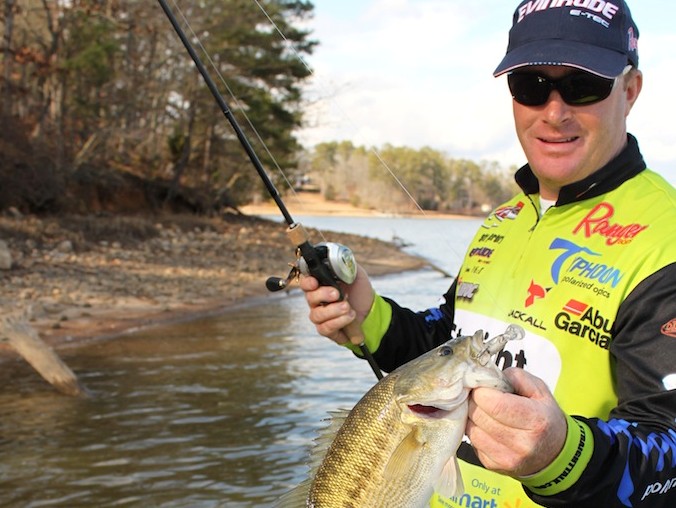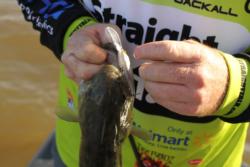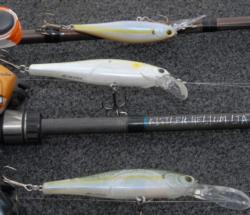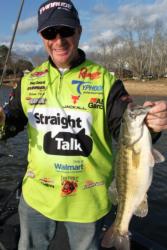Two winter classics: jerkbaits and finesse crankbaits
Understanding the when, where and why

If you’ve ever picked ice from your rod guides, if you’ve ever pried Vienna sausages from juice that was more solid than liquid, if you’ve ever ignored the warning on a package of hand warmers and put them in creative places for fear you might lose life or limb, then you’ve probably spent a cold day or two in a bass boat.
And if you’ve bass fished in the extreme cold, then you’ve likely thrown a couple of wintertime classics –jerkbaits and finesse crankbaits. Few lures have the ability to tempt lethargic bass in the dead of winter to open up and say ahh like these two. But there are some subtle differences that set these techniques apart from one another.
One angler well versed with both jerkbaits and finesse cranks is Straight Talk pro Scott Canterbury. Fishing all over the country, and especially on his home water of Logan Martin in Alabama, Canterbury knows the ins and outs of these baits better than most anglers.
When:
 “It all starts with water temp,” said Canterbury. “I like to throw a jerkbait year round but a finesse crankbait like a Shad Rap or Soul Shad doesn’t work that well when the water temp gets below 52.
“It all starts with water temp,” said Canterbury. “I like to throw a jerkbait year round but a finesse crankbait like a Shad Rap or Soul Shad doesn’t work that well when the water temp gets below 52.
“I’ve caught them down to 48-degree water but the conditions have to be right. If the water is really cold, you’ve got to have a little cloud cover or some wind blowing. Those fish have to have some reason to be up near the bank feeding.”
Once the water drops below 48, Canterbury almost always picks the jerkbait of the two. And his rule of thumb for jerkbait fishing is “the colder the water, the longer the pause and the slower the retrieve.”
Where:
The where is the second determinant in choosing one or the other. Even when water temps are above 52 degrees, a Shad Rap doesn’t work everywhere all the time.
“You need to always keep contact with the bottom,” said Canterbury. “If I’m fishing a Shad Rap, I’m bumping it off rocks or shallow wood.”

The cutoff on water depth is about 4 to 6 feet since that’s as deep as most finesse crankbaits will dive. If you’re fishing a shallow pocket, go with the crankbait. If you’re paralleling a bluff wall, pick up the jerkbait.
“Sometimes if you’re fishing a 45-degree bank, you might find the fish right on the bank early in the morning and catch them on a crankbait. Then when you come back later in the afternoon they’re out off the bank suspended in 15 feet of water. That’s when you have to change up and catch them on a jerkbait.”
Why:
As with many techniques, matching the hatch is exceedingly important. Realism proves to be one of the main reasons both of these baits work so well in the winter. With water temps so cold, reaction strikes are hard to come by. Fish move slower in cold water and thus get a much better look at what you’re presenting.
“You can pause a jerkbait and let it sit right in the strike zone,” said Canterbury. “The shad move really slow in the winter and that’s one reason they’ll eat a jerkbait. It just sits there like a struggling shad.  That’s also what makes a finesse crankbait so good. It has a really tight wiggle that looks just like a shad swimming off real slow.”
That’s also what makes a finesse crankbait so good. It has a really tight wiggle that looks just like a shad swimming off real slow.”
As long as shad are the predominant forage in your fishery, shad patterns are the best bet. If the water is really clear or really muddy, Canterbury will move away from shad patterns – using bright-colored jerkbaits in muddy water and crawfish-pattern crankbaits in clearer water.
“A crawfish scurrying along the bottom is going to get a reaction strike really quick,” added Canterbury.
And anything “really quick” when fishing in the cold is a good thing.
Tips:
Always use monofilament line with a jerkbait. Fluorocarbon sinks and thus drags the nose of the bait down, throwing off the action.
When fishing a finesse crankbait in water below 55 degrees, Canterbury favors monofilament to fluorocarbon, as most fluorocarbon lines tend to get brittle in the cold.
Keeping constant contact with the bottom inevitably leads to a little wear and tear. Be sure to keep an eye on the line near the knot on your crankbaits and monitor your hooks, making sure they are always sharp.
Experiment with the retrieve of both baits with the understanding that the colder the water, the slower the retrieve. It’s often necessary to pause a jerkbait 30 seconds at a time and longer.
For finesse crankbaits, a 7-foot, medium-action spinning rod or a 7-foot, light-action casting rod rigged with 6- to 8-pound test works best.
A jerkbait works well on a 7-foot, medium-action casting rod rigged with line anywhere from 8-to-17-pound test depending on what you’re fishing the bait around and how deep you want the bait to go.
Adding led stickers to the belly of a jerkbait allows Canterbury to get his bait down in front of deeper fish. He has caught fish hitting bottom in 18 feet of water on Logan Martin.
If it’s calm and slick, the jerkbait works the best. If it’s cloudy and the fish are really biting, go with the crankbait because you are able to cover a lot more water with it.